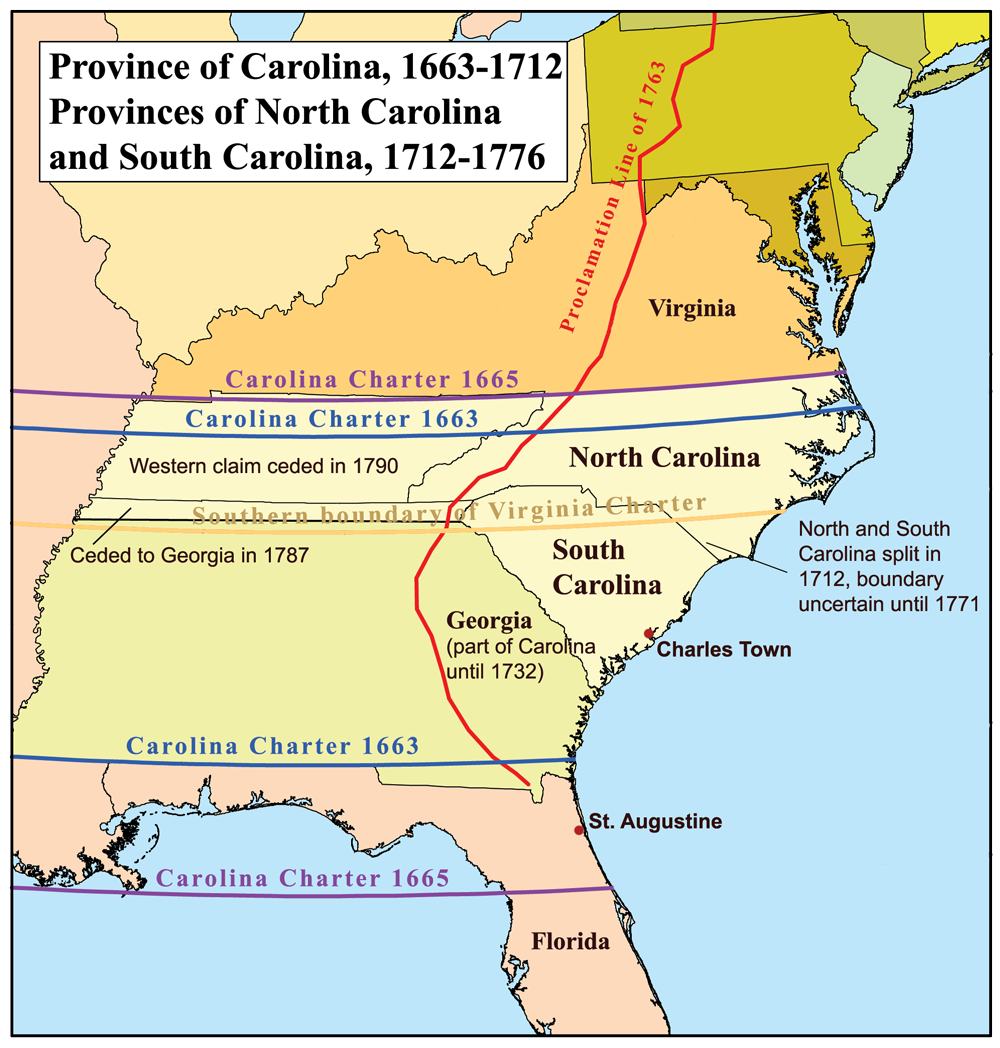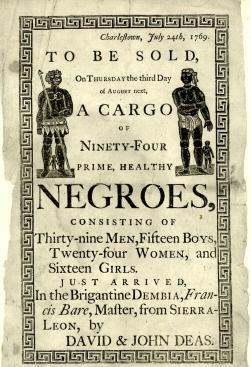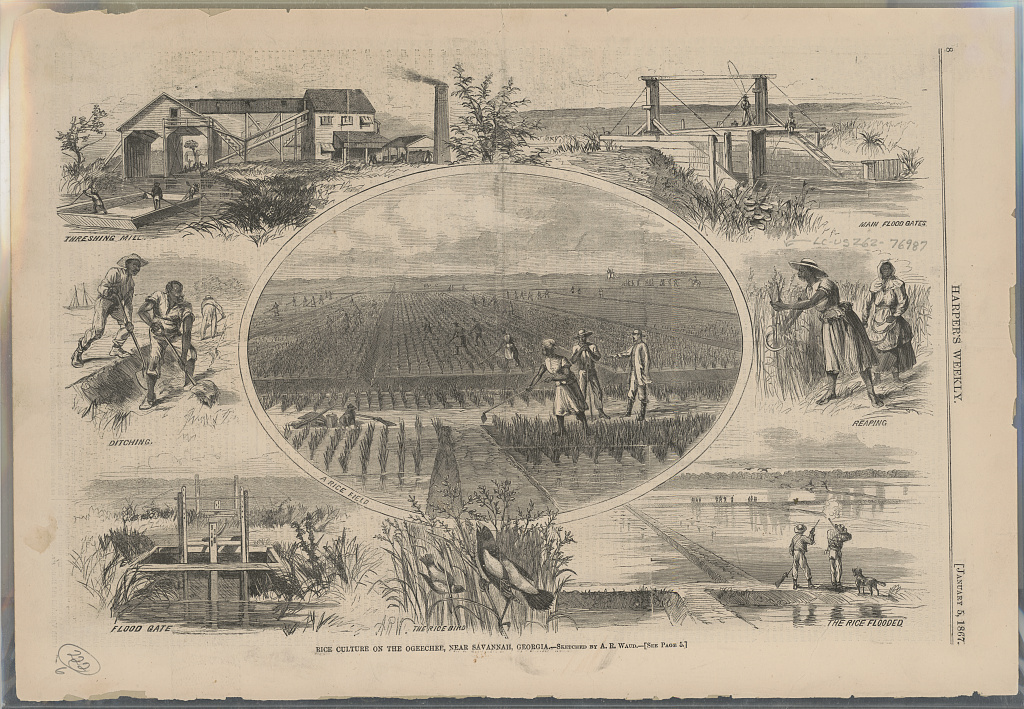3.4: Africans in the Low Country
- Page ID
- 22746
Unlike the Virginia and Maryland colonies, the Carolina colony essentially imported a preexisting slave system from the Caribbean in the late seventeenth century. King Charles II of England chartered the Carolina colony in 1663 and it quickly developed a thriving economy based on African, African-American, and Native American slave labor. Nearly half of the colony’s first white settlers came from Barbados in the eastern Caribbean where English landowners used African slaves on their sugarcane plantations. By the early 1700s, white plantation owners in Carolina relied almost exclusively on African and African-American slaves for labor on their rice and indigo plantations. Founded in 1670, Charles Town (later Charleston), soon became the colony’s capital, a center of culture, commerce, and political power rooted in slavery. During the eighteenth century, more than half of all enslaved Africans who came to British North America would pass through the city. (Carson, The Struggle for Freedom , 54–55)
In 1712, Carolina split into two colonies, North and South Carolina (See Figure 3–5). Later, in 1733, James Oglethorpe settled the Georgia colony with a charter from King George the II to the land between the Savannah and Altamaha rivers. The Low Country, an area of fertile fields and swampy salt marshes, includes 79 barrier islands or “Sea Islands” along the Atlantic coast from southeastern North Carolina to the St. John River in northeast Florida.
 Map of the colonies of North and South Carolina and Georgia and their origin dates.Figure 3-5 — Carolinacolony by Kmusser is licensed under CC BY-SA 2.5
Map of the colonies of North and South Carolina and Georgia and their origin dates.Figure 3-5 — Carolinacolony by Kmusser is licensed under CC BY-SA 2.5
Rivers and tidewater streams lace the coastal plain creating widespread wetland landscapes. For Africans arriving in the Low Country, the climate and the wetlands, rivers and winding streams, if not the pine forests, must have seemed familiar, reminiscent of the landscapes they left behind in the wetlands of West or West Central Africa.
From the very earliest years of the colony, 20 to 30% of the settlers were Africans of diverse ethnic origins. During the first twenty-five years, about one in every four settlers was African. By 1720, Africans had outnumbered the Europeans for more than a decade. South Carolina was the one British colony in North America in which settlement and African slavery went hand in hand (Wood 1974; South Carolina 2004a).Over 40% of the Africans reaching the British colonies before the American Revolution passed through South Carolina. Almost all of these enslaved people entered the Charleston port. After a brief quarantine on Sullivan’s Island they were sold in Charlestown, later called Charleston, slave markets (See Figure 3-6). Many of these enslaved people were almost immediately put to work in South Carolina’s rice fields. Writers of the period remarked that there was no harder, or unhealthier, work possible. In fact, colonial travelers described the Carolina rice fields as charnel houses for enslaved African-Americans (Wood 1974; Morgan 1998).
 Reproduction of a handbill advertising a slave auction, in Charleston, South Carolina, in 1769Figure 3-6 — Slave Auction Ad by Unknown is in the Public Domain .
Reproduction of a handbill advertising a slave auction, in Charleston, South Carolina, in 1769Figure 3-6 — Slave Auction Ad by Unknown is in the Public Domain .
In spite of the high death toll, a fortuitous combination of geographic and demographic factors, allowed these enslaved African peoples to shape their daily lives and customs according to African cultural traditions and to produce new African American cultural patterns. The first wave of Africans had more freedom to shape their culture than in any other part of the North American mainland (Morgan 1998:19). Not only did they live in autonomous units, in society as a whole, they made up a significantly large proportion of the population. As the eighteenth century opened Africans in South Carolina numbered 2,444, making up 75% of the total population. Within thirty years, there were 20,000 Africans, out-numbering Europeans 2:1. This was still the case in 1740. (Adams and Barnwell 2002). (3)
Rice Cultivation and Slavery in the Low Country
The second wave of African slaves brought to Carolina and Georgia after 1750 came from the Windward Coast of West Africa, a region stretching from Senegal down to Sierra Leone and Liberia. Traders acquired and sold Africans from this region because they came from rice growing cultures and brought with them technological and agricultural skills that were crucial to developing a thriving rice plantation system in the Low Country.
Geographer Judith Carney makes the case that Africans introduced sophisticated soil and water management techniques to Carolina and Georgia plantations. For tidal rice cultivation, an elaborate system of irrigation works—levees, ditches, culverts, floodgates, and drains—had to be constructed (and maintained) to control and regulate the flow of water onto and off of the fields. Carney explains that this agricultural technology and the hollow cypress logs known as “trunks” or “plugs,” used to control water flow in embankments, were African innovations in Low Country rice cultivation.
In the ten years following the Stono Rebellion, a 1739 slave uprising near Charleston that resulted in the deaths of more than two dozen whites, the colony developed indigo as a second cash crop. Indigo, like rice, was labor intensive and its cultivation and processing for trade was well also known to Africans from the Windward Coast.
With both indigo and rice production depending upon the importation of Africans skilled in their cultivation and processing, economics won out over fear of more slave rebellions. In the aftermath of the Stono Rebellion in 1739, the South Carolina legislature began a ten year moratorium on the importation of slaves from Africa, which ended in 1750. Over 58,000 Africans entered South Carolina in the twenty-five years from 1750 and 1775 making South Carolina the largest direct importer of Africans for enslavement on the North American mainland. (Carney 2001:89). Over time, descendants of these early generations of Africans came to be known as the Gullah-Geechee people who had and continue to have distinctive cultural characteristics and a shared heritage.
Between 1730 and 1774, Low Country rice exports increased from 17 million pounds of rice annually to 66 million pounds. For the enslaved African people, particularly the women upon who successful rice production depended, there was an accompanying increase in hard labor and physical disability.
Rice cultivation and processing were mainly women’s work. So it was in Africa and so it was on South Carolina and Georgia rice plantations. Enslaved men carried out skilled work making barrel staves for the crop’s shipment. Men also monopolized blacksmithing, and cooperage and performed the hard work of preparing rice embankments and ditches (Carney 2001:199–120). Ultimately, however, it was the labor of African women and their daughters that made the phenomenal growth of the Low Country rice economy possible (See Figure 3-7).
 Figure 3-7 — Rice Culture on the Ogeechee, near Savannah, Georgia by A.R. Waud is in the Public Domain .
Figure 3-7 — Rice Culture on the Ogeechee, near Savannah, Georgia by A.R. Waud is in the Public Domain .
African women brought three rice cultivation techniques to Low Country plantations: sowing in trenched ground, open trench planting, and tidal rice cultivation. A description of enslaved people’s preparation of rice for open trench planting in the nineteenth century corresponds with the contemporary rice planting system in Sierra Leone in West Africa as well as with descriptions of late eighteenth early nineteenth centuries methods used in South Carolina:
Young men brought the clay water in piggies[sic] from the barrel and poured it over the rice, while young girls, with bare feet and skirts well tied up, danced and shuffled the rice about with their feet until the whole mass was thoroughly clayed,…When it is completely covered with clay, the rice is shovelled [sic] into a pyramid and left to soak until the next morning, when it is measured out into sacks, one and one-fourth bushels to each half acre…(Pringle 1914:375–376).
Enslaved women pressed the rice seeds into the muddy ground with their heels. Afterwards men called “trunk minders” flooded the fields to encourage seed germination.
“It is literally casting one’s bread on the waters … for as soon as the seed is in the ground the trunk door is lifted and the water creeps slowly up and up until it is about three inches deep on the land. That is why the claying is necessary; it makes the grain adhere to the earth, otherwise it would float (Pringle 1914:12–13).”
Once the seeds sprouted, enslaved men drained the fields and the women weeded them. Weeding the rice fields had to be done by hand. The fields were then alternately flooded and drained to keep the soil moist and the weeds under control, and to deter the birds and other animals. The final flooding took place under the watchful eye of the “trunk minder,” who was responsible for gradually raising the water level in the fields to support the top-heavy rice stalk.
After harvesting the rice, allowing for a short period during which it dried, the enslaved women processed the rice. First, they threshed the rice to remove the rice grains from the stalks. Threshing entailed beating the rice with a stick or having the farm animals trampling the stalks. Next, they pounded the rice using a hand-pounding mortar and pestle to separate the indigestible hulls from the rice.
Pounding rice required great skill to insure that the majority of the end product was clean whole grains rather than partially broken or small broken pieces of rice. African women were highly skilled in pounding rice. However, processing rice for subsistence use as they had done in their West African homeland was quite different from processing rice as a cash crop.
Pounding rice was grueling work. In West Africa, women pounded enough rice for a family’s meals. In the Low Country, throughout the eighteenth century, enslaved women pounded about 44 pounds of rice a day, cumulatively millions of pounds of rice for export.
After pounding, they then poured the rice onto a fanner for winnowing. Then they removed the indigestible hulls, or chafe, by tossing the rice up and down in the wide shallow fanner basket. During this process the basket was gently tilted back and forth, tossing the rice upward and outward, allowing the husk to be blown away by the wind. (Careny 2001)
In eighteenth century South Carolina, African women made the winnowing baskets from light grasses and palmetto leaf. Anthropologist Dale Rosengarten has established that the weaving style of winnowing baskets and the process of winnowing passed down from South Carolina slaves to their Low Country-born African Americans descendants, are West African, not Native American, in origin (Rosengarten, 1986; Carney 2001:114). Coiled grass baskets are a tradition in many parts of West Africa. Descendants of enslaved Africans who came to the Low Country made baskets for winnowing and other purposes in the 1700s, and the tradition continues among many Low Country African-Americans today.
After harvest, men and women both worked to prepare the fields for the next rice crop. This was arduous work but none was as arduous as processing the millions of pounds of rice for shipment overseas, mostly within a few months when the crop was in greatest demand.
As onerous as pounding seven mortars of rice or splitting 100 poles for fences, trenching, hoeing, or plowing 1 / 4 to a 1 / 2 acre of land per day must have been, the burden was mitigated by the knowledge that at the end of the task was “free time.” The task system of work assignment was perhaps the most distinctive and central feature of enslaved African life in the Low Country. By the end of the eighteenth century, the task system was firmly entrenched from South Carolina to Florida, wherever rice was cultivated, and planters extended the system to organization of labor in raising Sea Island cotton.
Under the task system, a person was assigned a certain amount of work for the day after which he or she could use their time as they pleased (Morgan 1982:566). “Owning” time, making one’s own decisions, owning the products of one’s labor, were powerful ideas, empowering incentives and in the end led to positive outcomes for enslaved low country Africans.
After they [slaves] finished “their required day’s work, they were given as much land as they could handle on which they planted corn, potatoes, tobacco, peanuts, sugar, watermelons, and pumpkins and bottle pumpkins… They plant for themselves on Sundays…They sell their own crops and buy some necessary things…” wrote Johan Bolzius of low country slaves in the mid-18 th century (Bolzius 1750:259–60, Translated and edited by Loewald, Starika and Taylor, 1957).
Once gained, “free” time expanded allowing enslaved people not only the opportunity to tend their own crops but also to socialize, grow and sell surplus products, gain personal property through such sales and ultimately to accumulate money to purchase their own freedom and that of their family members.
In South Carolina a series of laws passed between 1686 and 1751 reflect the growing concern of slave holders over the ways in which the Africans chose to spend their “own time.” A 1686 law prohibited the exchange of goods between slaves or slaves and freemen without their master’s permission. Ten years later the lawmakers tried to prohibit slaves felling and carrying away timber on lands other than their masters. In 1714, the legislature prohibited that “slaves plant for themselves any corn, peas, or rice,” apparently to no avail since 20 years later another act was passed allowing patrollers to confiscate all fowls and other provisions found in the possession of “stragling [sic] negroes.” Many planters came to depend upon the foods, goods and services provided to them by the Africans. At best, their dependency must have made them ambivalent about enforcing the prohibitive laws.
Low Country slaves raised crops that reflected their African origins such as okra, groundnuts (peanuts) sesame seed, called Benni, and “Read {sic} peppers.” African vegetables and rice became part of the staple diet of new generations of African Americans and were eaten by planters as well. Both Elias Ball and Eliza Lucas Pinckney mention, for example, “negro” grown peppers in their letters (Morgan 1982:574). Enslaved entrepreneurs branched out from huckstering foods to making and selling other commodities such as canoes, baskets and wax (Ball, 1837).
Over time, enslaved people used surplus income from the internal economy to buy livestock, including horses, and one at least negotiated his own freedom (Morgan 1982:580). After completing their tasks for the slave master, the African men hunted, fished, worked as carpenters and in other trades to earn money. The women washed clothes, prepared food and cooked for their families, raised chickens and vegetables to eat and to sell. These activities allow the Africans to participate in trade and cash sales through which some men and women earned and saved money to buy themselves and their kin out of slavery. By the time of the Revolutionary War, two or more generations of native-born African Americans, had a variety of occupational skills that they used to earn enough money to buy freedom. However, even those who continued enslavement gained a degree of autonomy through internal economies that developed throughout the colonies. (3)
Conclusion
By late eighteenth century, before the colonies convulsed during the American Revolution, racial slavery had become rooted in the soil and law of colonies stretching from Georgia north to New England. But nowhere was slavery more important to British North American economy than in the Chesapeake colonies of Virginia and Maryland, and the Low Country colonies of South Carolina and Georgia. The extraordinary wealth African and African-American slaves produced for white plantation owners not only created an economic aristocracy, but a political ruling class who also cherished the liberty and freedom slave labor made possible for them.
As colonists began to revolt against British rule during the 1760s and 1770s, they often viewed their plight through the lens of slavery. They saw Parliament’s infringement upon their rights and privileges as British subjects as akin to enslavement and many colonial leaders in turn used the language of natural rights, of liberty and freedom, in their fight for independence from Britain.
During the American Revolution, many African-American slaves would seize upon this language to demand their own freedom from slavery. Others would flee their masters during the chaos of war and fight alongside the British against the rebellious colonists or else join the patriot cause and fight in the Continental Army and Navy in hope of securing their freedom at the end of the war. Regardless of the side they fought on, African-Americans forced whites to confront the ironies and contradictions of fighting a revolution in the name of natural rights and liberty while choosing to maintain slavery. (1)


